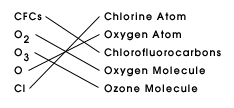

Wrapped around Earth is the atmosphere, which has evolved over the course of billions of years. Without this protective blanket of gases, life as we know it would be impossible. In comparison to the size of our planet, however, the thickness of the atmosphere is like that of the skin on an apple, and it's perhaps much more fragile than we'd like to imagine. The effects of changes in the atmosphere such as an increase in "greenhouse gases" and ozone depletion can be studied in Antarctica by looking at plants, the ice sheet, sea ice and solar radiation.
Ozone protects all living things on Earth from the damaging effects of ultraviolet light by absorbing most of the harmful ultraviolet radiation (called UV-B) from the Sun, which can be very damaging to living cells. UV-B causes some types of skin cancer and eye diseases in humans.
In 1985 British scientists published their findings on a strange and unexpected occurrence over Antarctica. They noticed that large amounts of ozone had disappeared over the continent during September (as sunlight returns after months of darkness), but that during November and December ozone levels returned to normal. Since 1985, while varying in extent from year to year, the now-notorious "ozone hole" has covered a wider area, has extended further up and down in the atmosphere, and lasted longer.
The chemical explanation of ozone depletion is as follows:
Ultraviolet light strikes a CFC molecule and causes a chlorine molecule to break away. The chlorine collides with an ozone molecule (O3) and steals an oxygen atom to form chlorine monoxide and leave behind a molecule of ordinary oxygen. When a free atom of oxygen collides with the chlorine monoxide, the two oxygen atoms form a molecule of oxygen (O2). The chlorine atom (Cl) is thus released, and is free to destroy more ozone.
The ozone hole appears over the Antarctic during austral spring for two main reasons.
Objectives
Students will construct a Parts Per Million (PPM) model of normal atmospheric ozone.
Students will illustrate and describe chemical processes causing ozone depletion.
Students will research the latest findings on Antarctic ozone depletion, by going on-line and using other research tools.
Brainstorm with class what they know about ozone and/or the ozone hole. List the following chemical symbols on the chalkboard and ask students to match each symbol with its name.

Ozone (O3) is a special form of oxygen molecule
that consists of three atoms of oxygen bonded together instead of the usual
two. It's normally present in the upper atmosphere in concentrations of
just 10 to 15 parts per million. This is enough to filter out most of the
deadly ultraviolet radiation (UV-B) that comes from the sun. Explain that
in Activity 3.1.1, Parts Per Million, students will illustrate the fraction
of the upper atmosphere that consists of ozone.
![]()
![]()